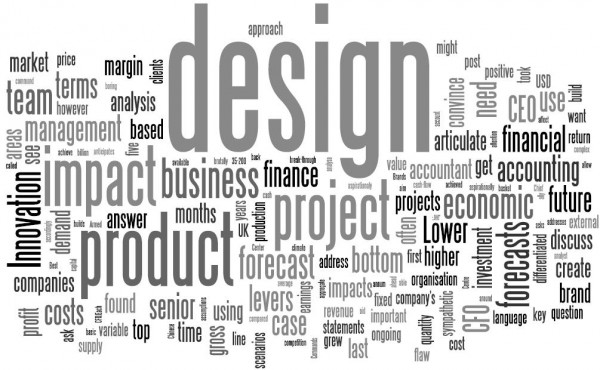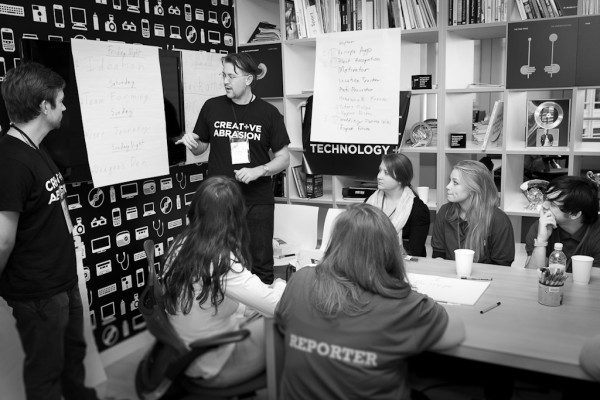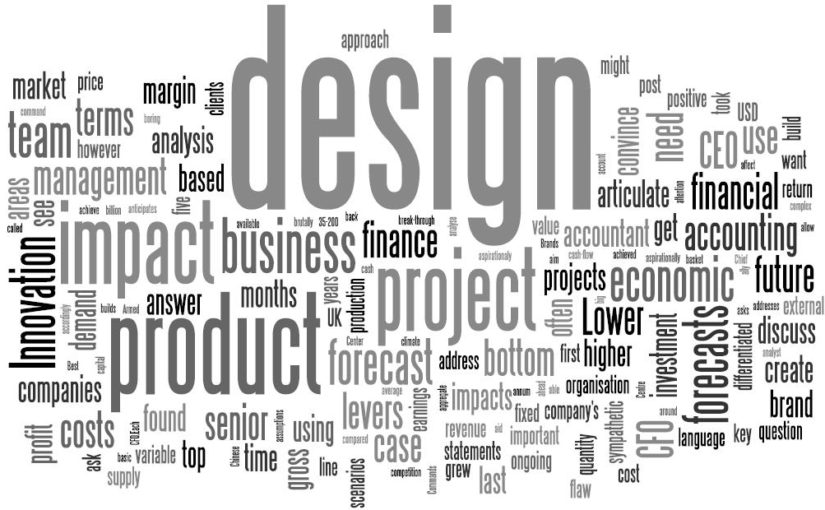Marketing and design a very different mindsets and professions. I’m guessing that both your company’s marketing and your design probably sucks. But then again so does everyone else’s. It’s been driven to blandness by a combination of focus groups that couldn’t “get” your new idea, repeated changes from your management team, internal squabbles and old ideas left over from a time when advertising spend equalled market success. But maybe there is an even deeper problem…

The difference between marketing and design isn’t obvious. They’re different professional disciplines but the real difference is in the mindsets that they bring to approaching a problem.
Design vs Marketing
If you don’t have a great product, then no amount of marketing and advertising will help you. What might just help is design. In particular, a way of approaching new product development, business strategy and marketing problems that’s called design thinking. You still need traditional marketing to execute and scale, but for new ideas or new brands you’ll need a new approach and design thinking is built for creating new things.

These days, in the startup scene, the mindsets of design thinking are well defined, well understood and well appreciated. But just today a marketing manager stopped me in my tracks in the middle of a meeting. She asked me,
“Everything you’ve told me about ‘design thinking’ just sounds like good marketing. What gives?”
To be honest, I was slightly lost for words and this blog post is really just my attempt at a proper answer. Design isn’t just good marketing. It’s a fundamentally different way of approaching problems within your business. When I’m talking about design and design thinking, I’m not just talking about marketing vs graphic design. I’m talking fundamental differences in how we see our customers.
How marketers think
Marketing thinking is all about seeing people in aggregate so that you can communicate with them as efficiently as possible. By contrast, design thinking is all about seeing people as individuals so you can delight that one person and then extrapolate that out to others.
The best place to see this is in a focus group. Focus groups that are reviewing a concept will tend towards the views of the average. This results in the overwhelming blandness of the products that you see on your supermarket shelves. There is a very healthy place for focus groups in the insights, research and needs identification parts of the process. But not in testing or reviewing your new brand or new product. Instead, the Google Ventures Sprint based approach, or the Ideo design thinking approach would seek to go and find a smaller number of customers to really deeply understand how they view your product.
Marketing strategy
Marketers made good business strategists and product managers. A wise old friend of mine (with a Stanford MBA) who’s a successful entrepreneur and investor recently reminded me that in business you really only have three options for winning:
1. Be the biggest and win by being the cheapest,
2.Be the smallest and win by staying under the radar, or
3. Be different.
If you choose option (3), which most companies say they want to do, then you’d better get aware of how design can help your whole business understand your customers and create difference. – And fast. Because someone pursuing option (1) with an army of marketing experts, and someone pursuing option (2) with an invention in their garage are both coming after you.
How designers think
The most powerful thing I did to learn about how designers think was to read Thoughtless Acts by Jane Fulton Suri from Ideo. It’s a simple book with photos of things that people have improvised to adapt the environment around them. Like hanging the wires from iPhone headphones over their ears when not in use or putting a plastic bag over a parking meter to signal to everyone else that it’s not working. This style of design thinking is really all about honest empathy with your customers.
Design strategy
Design thinking is a style of problem solving that’s available to anyone. The most important part is to start with the user and work everything backwards from the moment of end-use. This type of “human centred” design is at the core of design thinking. User interface designers and industrial designers are trained to think like this all the time.
Management professionals can try on design thinking by using gamestorming, design sprints and empathy techniques like user observation and anthropology. Just getting a taste of design thinking isn’t the same as being an expert, but any increase in empathy for your customers will help improve your products.
Bringing design and marketing together
To be fair, you still need a marketing strategy and you still need to tell your story and get the word out. But maybe it’s worth having your own story to tell first. I’ve found that using a marketing approach too early on in the process leads me to ask the wrong questions. For example:
- Marketing: What will please the greatest number of people just enough to buy our product?
Whereas, using a design approach at first tends to lead me towards empathy, user centrednesss and creativity to ask questions like:
- Design: What will delight the specific person that we created this for, so much that they tell other people about it?
Creatives in advertising agencies have the same conflict with marketing people that designers often have internally. Fundamentally, marketing is about talking to a group, whereas design is about creating something for an individual. Both are important skill sets at different stages of the process. But in the end, would you rather buy from a company that saw you as a bland demographic or as an interesting individual?

In our business the marketing team creates new product concepts and collaborates with the design team to bring them to market. I get that you are talking about “design thinking” in this post which is a bit different to what we do but I’m not so sure about the whole Design vs. Marketing thing.
Great conversation. As a designer of 25 years, I am disappointed to be structured UNDER a marketing manager in the corporate sector. Even though designers understand the distinction, it appears that marketers strategically position designers beneath them to earn more money and control design thinking.
I have seen this structuring problem result in the most bland and uninspired thinking by designers and heard experienced designers complain about being told what to do and micromanaged by junior marketing people.
A word of advice to senior managers in the corporate sector. Get your creative people out from under marketing. And give them the freedom to create ideas and to inspire themselves. And watch your creative culture change for the better.
Boutique design studios and ad agencies don’t have designers reporting to marketing people. For some reason, bringing a designer in house and under marketing throws creativity under the bus.
Marketers are not creatives. Maybe in the old days when they came from radio or TV or media backgrounds. But not in the last ten years since being pumped out of university with big ambitions of getting designers under them. The disrespect I have endured from some of these people who are poor planners, poor writers and have poor knowledge of the digital space is astounding. Yet they are usually happy to take the designers ideas and promote them as their own.
As far as I can tell, you don’t need talent or work ethic to work in marketing, dropping the word ‘strategy’ into every second conversation (without ever expounding on it) seems to be enough.
If it isn’t clear, I am annoyed. And I hope gen Y designers give this topic a good kick in the guts. And don’t put up with being made to look inferior to marketing in the corporate sector. Get a voice to senior management and push for a creative director to work under.
Nice blog Peter (and small world indeed!)
Great to see someone else so vocal in the design-led business space.
So much opportunity and need for this stuff
A few points … Marketing is about creating mutually beneficial exchanges … not communicating to people … that is Sales on a one on one basis and Advertising one to one or one to many …. Marketing advises on messaging
Design is about developing usable forms … business model development is what strategy is all about … let’s not overstate what design does or it ceases to have meaning
the big difference between marketing and designing to me is CREATIVITY , a designer thinks totaly different to how a marketing person would, we are trained to think in an “out side the box” way, look at all the greatest ads out there, they are not done by a marketing team, you need someone with a wild imagination to come up with all the amazing stuff you see out there , anythow i think everyone thinks they are creative and can create, but lets face it, anyone can study and become a marketing person, not everyone can become a creative designer 😀
Great topic for conversation..
I too was asked the same question in a meeting:
So I get the fundamentals of the design process, and they sound similar to those of a good marketing process, but what is the fundamental difference between marketing and design?
I too was unprepared for this question…but I am a great believer in the fact that in your darkest hour, lies your greatest opportunity…..
I think you are onto something with the whole argument of mass versus individual and I do believe a lot of designers go into design for the right moral reasons. I saw this at University and have also witnessed it in my 10 year design career too.
My answer (and it took me a while to arrive at it) is:
Marketing is focused on the story and brand proposition..how can we tell it in a different light or put a different spin on it? How do we come up with a different and meaningful proposition through story and brand communications?
Where, design has and will always be focused on experience..becoming intrinsically involved in the thing you are designing, putting yourself in the shoes of the person you are designing for. When I worked in the consultancy field we had little to no money for research, which meant we did it ourselves, which in turn meant that if we were designing something, we would have to first understand how it was used in context. We would have to empathize with the users and listen to their needs, and put ourselves in their shoes to fully understand what they were experiencing. Only when we went through the experience of use would we understand the problems, which in turn would lead to the opportunities…
Thanks for the topic….
Two years later, this holds up beautifully. Thanks.
The connection between design to marketing is inextricably certain, with design making the change between good results and disaster between one business and its rival.
Perfect answer…thanks so much. This comes at a time when I have to choose whether to name myself a marketer or a designer and I appreciate that you’ve made the distinction in this way.
Thanks for your comment on my Idealog story on design thinking! This is a fantastic post – really nails the essence of DT vs marketing, which is so often fuzzy. I may have to refer back here in the future…
Thanks Esther. Design and marketing are very closely related but (as Idealog have always championed) Design Thinking has a valuable role to play in business creativity.